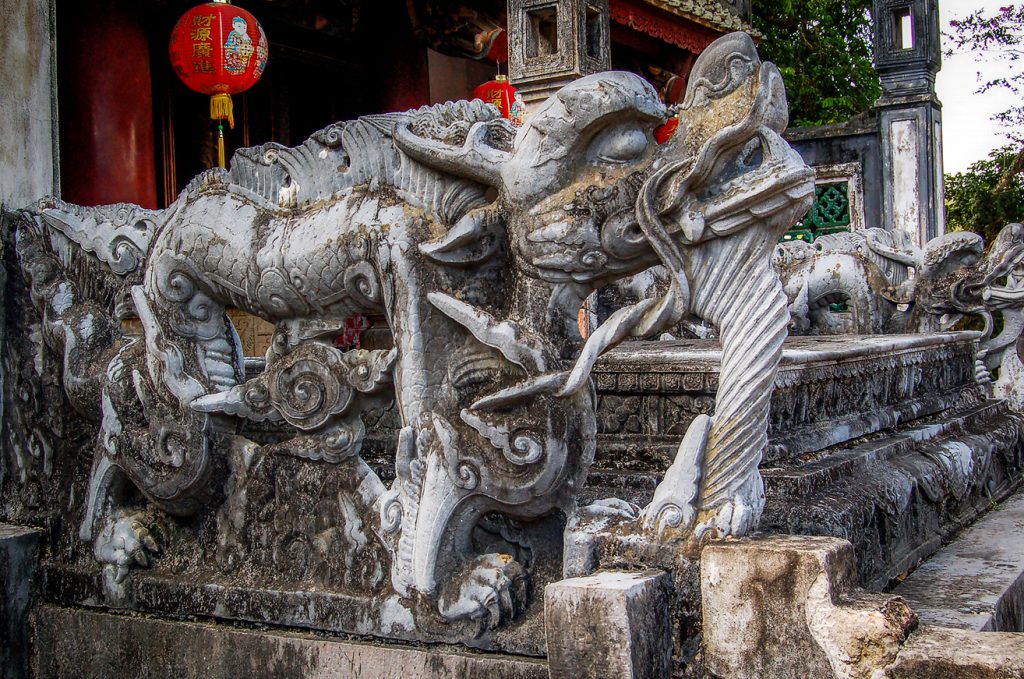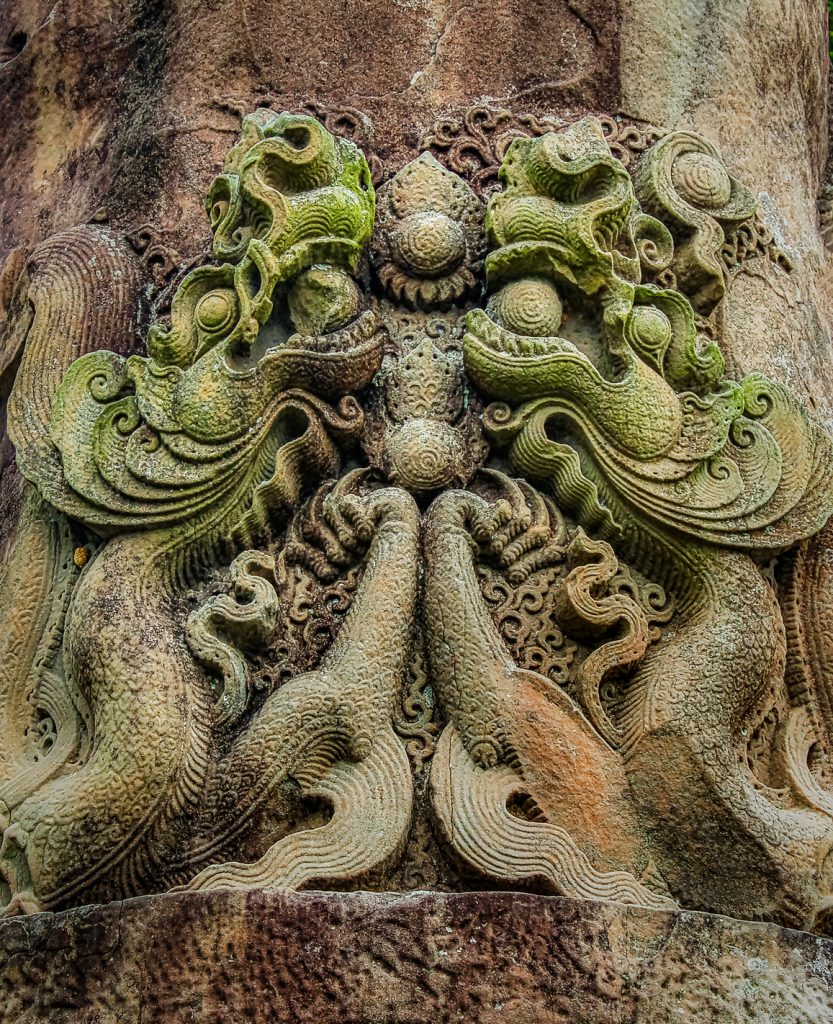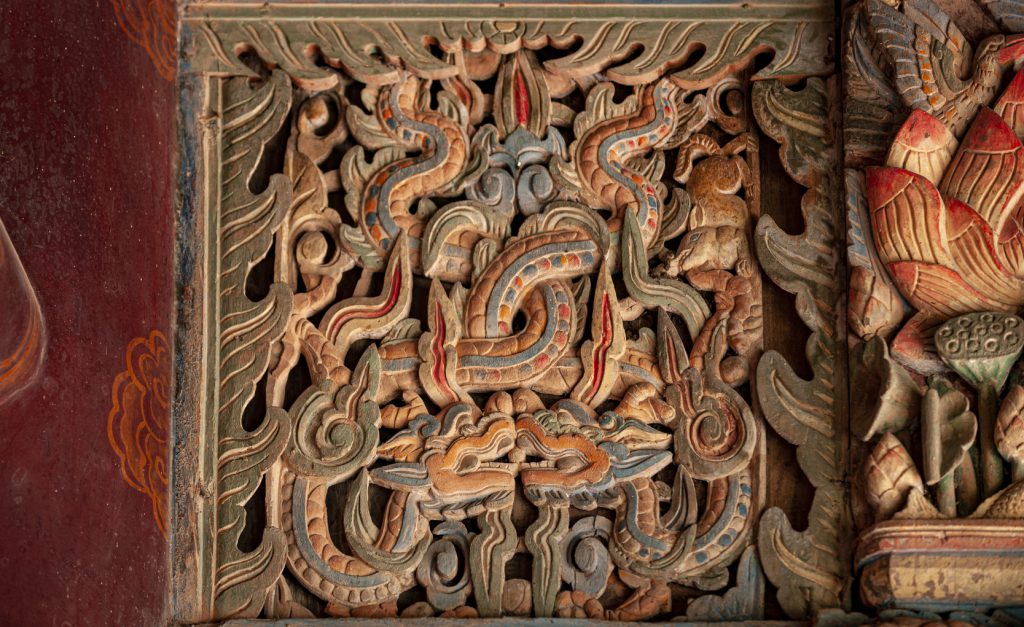Phan Cam Thuong
The symbol of the dragon is universally recognized in legends all over the world. In the West, the dragon does not represent royal power, but tends to be associated with evil forces. In the East, the dragon symbolizes the emperor or king, regulates the weather, and embodies fertility in agricultural societies. Regardless of the philosophy or power it symbolizes, the dragon’s origin story is quite consistent, all around the world.

As humans emerged from caves, they harbored fears stemming from three mighty forces: the lion or tiger on land, the serpent or ferocious aquatic reptile in the water, and the great eagle and other predatory birds in the sky. These formidable adversaries were agile and strong, with sharp claws and fangs. They could eat humans at any time. Gradually, people amalgamated attributes of all three creatures into a single image, named the dragon. The dragon has the head of a lion, the body of a serpent, the scales of a fish, and the antlers of a deer rhino. Western dragons have wings, while Eastern dragons are wingless yet soar through the clouds and spout water to bring rain. The horse combined with the lion and fish became the “Longma” (Dragon Horse), or unicorn, with the body of a horse but the head of a lion and a scaly body. These concepts likely also originate from similar phonetic roots: dragon (English), lủng/ long (Chinese), rồng (Vietnamese), etc.
It is believed that the earliest archaeological depictions of dragons date back to the Neolithic period in China, around 5,000 BCE. The earliest written reference to dragons is found in the works of Confucius, around 2,000 BCE. In Vietnam, dragons appeared on relics from the Ly Dynasty (1010 – 1225), and remained prevalent throughout a millennium of autonomous feudal rule. However, traces related to dragons can also be found in carvings on Dong Son bronze drums from about 2,500 years ago. In the West, dragons became prominent in the Middle Ages, from around the 7th to 14th centuries. In Hinduism, the Makara – a sea creature – is also considered to be a type of dragon. It is commonly seen in Champa art.
According to research by Robert Beer, as documented in “The Handbook of Tibetan Buddhist Symbols”, the Chinese dragon is believed to consist of three primary species and nine subsidiary types. The three primary species are: the thunder dragon with lungs or antlers, the hornless sea dragon, and the “Jiaolong” (Ch.chiao), a scaled dragon living in marshes and caves. The nine sub types include: the celestial dragon, divine dragon, winged dragon, coiled dragon, horned dragon, snouted dragon, golden dragon, water dragon, and dragon of hidden treasures. These twelve types are named in Han Chinese and researched by Chinese scholars. They are also known to the Vietnamese.

Further research by Robert Beer suggests that a dragon is typically composed of three parts and nine distinctive features. The three parts are from the head to the front claws, from the front claws to the waist, and from the waist to the tail. The nine features are: a head like a camel’s with antlers like a stag’s and eyes like a demon’s, a rabbit’s, or a shrimp’s; a neck like a snake’s with fish-like scales; a belly like that of a frog or a giant clam; ears like an ox’s; forearms and paws like a tiger’s; and talons like an eagle’s. Along its back are 81 flame-like scales and sharp spines that protrude from the jaw, chin, knees, and tail. A beard resembling a carp’s extends from the dragon’s upper lip, while its mane swirls and billows like that of a horse. The wild dragon’s eyes gaze fiercely beneath arched eyebrows. Its teeth are sharp, and its tongue is long and coiled. From its forelegs spring bolts of lightning as the dragon twists through billowing clouds, with all four limbs tightly clutching precious jewels.
Living in an agricultural society, ancient Vietnamese considered the dragon a celestial force, counterbalanced by the terrestrial force of the tiger. Both dragon and tiger were worshipped, with the dragon revered as the rain deity, commanding the wind and transforming the weather, aiding the fields and crops. The dragon was a symbol of the king, the emperor, and the gods. In carvings from the Ly – Tran dynasties, the dragon also symbolized the blooming and transcendence of Buddhism.
From the early Le dynasty onwards, the dragon seemed to become the exclusive emblem of the feudal court. The carvings on the Vinh Lang stele of Le Loi, with a dragon positioned between a circle and a square, represented the king as the Son of Heaven situated between the round heavens and the square earth. The king’s dragon bore five claws, a design that was absolutely immutable and not to be imitated; henceforth, the robes of officials, depending on their rank, could be embroidered with dragons, but always with four claws or less. Similarly, local communal houses, temples, and pagodas were not allowed to feature five-clawed dragons. Paired dragons – Two Dragons Facing the Sun, or Moon – symbolize the harmony of yin and yang, which creates existence.

According to ancient astrology, the dragon ascends to the heavens at the spring equinox, bringing rain, wind, thunder, and lightning, and coils back into the deep abyss at the autumn equinox, only to reappear the following spring. The sacred life force of the early days of the Lunar New Year, resonating with mystical legends about dragons, ensures that this image holds a special place in the cultures and beliefs of Asia.










